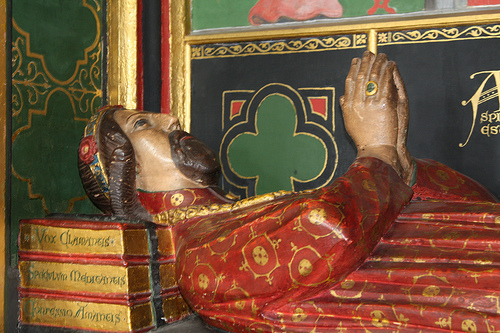| John Gower has a magnificent, brightly coloured tomb in the north aisle
of the nave of Southwark
Cathedral in London, England.

Tomb of John Gower,
Southwark Cathedral (Photograph by
Tony
Avon)

John Gower
His head rests upon his three main
works: Confessio Amantis, Vox Clamantis
and Speculum Meditantis which were written
respectively in English, Latin and French.
Gower was one of England's earliest
poets - a contemporary of William Langland and a friend
of Geoffrey Chaucer. It is
likely that he came from a wealthy family from Kent and
that he was trained in the law.
Gower was highly thought of during his
life time and enjoyed the patronage of Richard II. It is
said that Gower met the king while rowing on the River
Thames and was invited aboard the royal barge. This
meeting inspired him to write Confessio Amantis -
a work consisting of 34,000 rhymed couplets.
When Chaucer went abroad on his
diplomatic tours he nominated Gower as one of his
attorneys. Chaucer dedicated Troylus and Chriseyde to him
in the following manner: 'O moral Gower, this book I
directe/ To thee'. In return Gower provided a tribute to Chaucer in
Confessio Amantis. However, it is possible that
the two poets became estranged later in life as this
tribute does not appear in subsequent versions of the
poem. Shakespeare lifted
the plot for his play Pericles, Prince of Tyre
from Confessio Amantis.
Gower remarried at the age of 70 in 1398
and two years later he went blind. Most of his final
years were spent in the priory of St Mary Overies in Southwark.
(St. Mary Overy was the previous name for Southwark
Cathedral.)
Here is the first section of The
Prologue from Confessio Amantis :
|







